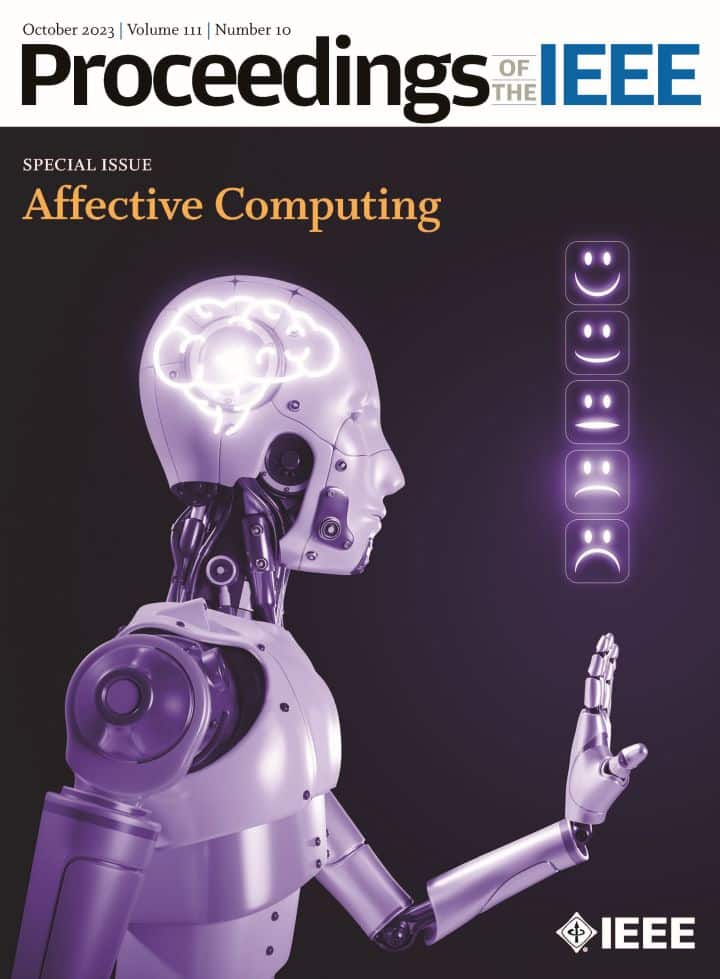2023 Journal Issues October 13, 2023


Guest Editors
Björn W. Schuller and Matti Pietikäinen
Special Issue Papers
By B. W. Schuller and M. Pietikäinen
By C.-C. Lee, T. Chaspari, E. M. Provost, and S. S. Narayanan
The article provides an overview on the state-of-the-art in speech emotion recognition, focusing on how to make the technology available to everyone.
By S. Zhao, X. Hong, J. Yang, Y. Zhao, and G. Ding
This article introduces label-efficient emotion and sentiment analysis from the computational perspective, focusing on state-of-the-art methodologies, promising applications, and potential outlooks.
By J. Yang, Y. Hristov, J. Shen, Y. Lin, and M. Pantic
This article discusses facial expression analysis based on facial action units, outlining three key needed assets and their challenges and introducing an end-to-end approach to the problem.
By y G. Zhao, X. Li, Y. Li, and M. Pietikäinen
This article investigates facial expressions on the “micro”-level, providing a detailed survey on a psychological and computer science perspective and the state-of-play in this exciting subfield.
By J. Z. Wang, S. Zhao, C. Wu, R.B. Adams Jr., M.G. Newman, T. Shafir,
and R. Tsachor
Drawing insights from psychology, engineering, and the arts, this article provides a comprehensive overview of the field of emotion analysis in visual media and discusses the latest research, systems, challenges, ethical implications, and potential impact of artificial emotional intelligence on society.
By Y. S. Can, B. Mahesh, and E. André
With affect not only impacting behavior, but also physiological responses, this tutorial deals with practical aspects of assessment in everyday life and the challenges coming with this setting.
By D. Wu, B.-L. Lu, B. Hu, and Z. Zeng
This tutorial guides the reader into the basics of brain–computer interfaces (BCIs) leading into “closed-loop” affective BCIs that include the chain from analysis to brain stimulation.
By T. Olugbade, L. He, P. Maiolino, D. Heylen, and N. Bianchi-Berthouze
This survey deals with touch in human interaction as a marker of emotion, looking into the epistemology, main findings, and ever-present challenges in this subfield’s literature.
By A. Triantafyllopoulos, B. W. Schuller, G. ˙Iymen, M. Sezgin, X. He, Z. Yang, P. Tzirakis, S. Liu, S. Mertes, E. André, R. Fu, and J. Tao
This article covers the synthesis of affect and the modality of speech, particularly synthesis and conversion of speech targeted to an emotion, with a focus on deep learning.
By C. M. de Melo, J. Gratch, S. Marsella, and C. Pelachaud
This article stresses the relevance of the ability to incorporate visual and motion behavior generation into human–machine interaction. It links emotional expression and social function in a psychological perspective and presents approaches to realize those expressions across multiple modalities.
By B. M. Booth, N. Bosch, and S. K. D’Mello
This article provides a multicomponential definition of engagement, reviews its conceptualization, and introduces its detection within context. It discusses pro- and reactive ways of boosting engagement in learning applications.
By G. N. Yannakakis and D. Melhart
This article surveys affective computing applications in gaming. Alongside the state-of-play, principles, approaches, and tools, it discusses the affective loop: game affect elicitation, sensing, detection, and adaptation.
By L. Devillers and R. Cowie
This article summarizes ethical considerations on affective computing. Dangers include oversimplification of affective states, lack of grounding in reality, potential addiction to affective systems and implicit dependence on those controlling the systems, and potential manipulation among others.